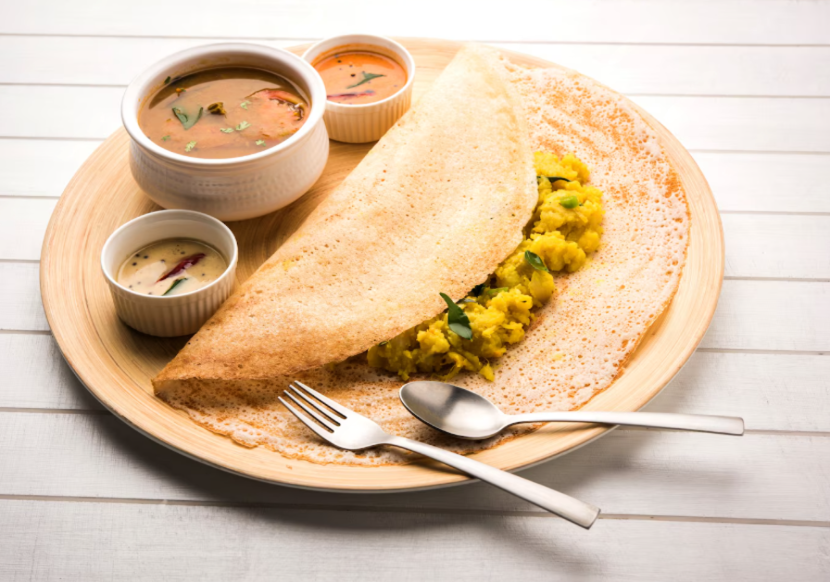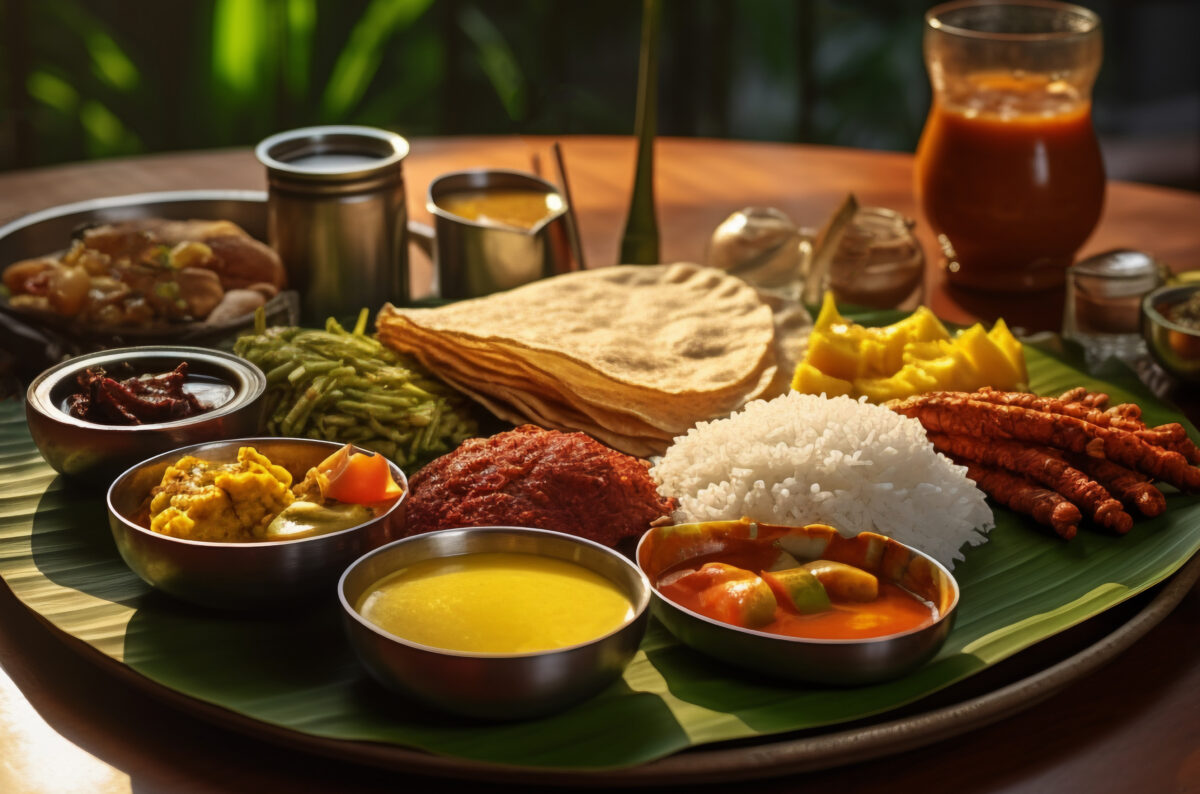
- April 9, 2025
51 Types of Dosa: Exploring India’s Most Loved Crepes
Dosa is more than just a dish; it is a cultural symbol that has become a staple in many households across India and around the world. Known for its crisp texture, versatility, and endless variety, dosa offers something for every palate. The beauty of dosa lies in its simplicity—rice and lentils are transformed into a light, crispy crepe that can be enjoyed with a variety of fillings, toppings, and accompaniments. Whether you’re a fan of classic flavors or you’re looking to try something new, the world of dosa offers 51 types of dosa to explore.
From regional dosa types to unique dosa recipes, each variety has its own history and flavor profile, making dosa an integral part of South Indian cuisine. In this article, we will delve into 51 types of dosa, examining everything from the iconic Masala Dosa to fusion creations that blend traditional dosas with modern ingredients.
What is Dosa?
Dosa is a thin, crispy crepe made from a batter of fermented rice and urad dal (split black lentils). Originating in South India, dosa has become one of the most famous South Indian foods loved across the globe. Traditionally served with chutneys and sambar, dosa is an incredibly versatile dish that can be served as a snack, breakfast, or even a main meal.
The dish has evolved over time, with many dosa varieties emerging, each influenced by regional preferences and ingredients. Whether served plain (Sada Dosa) or stuffed with a spiced potato filling (Masala Dosa), the dosa offers a delightful mix of crispy, soft, and flavorful textures. The growing popularity of dosa has led to the creation of unique dosa recipes that combine local ingredients and fusion flavors.
The Science Behind a Perfect Dosa
To make the perfect dosa, the ingredients must be carefully selected. The traditional dosa batter consists of rice, urad dal (lentils), and water. The key to achieving the perfect dosa lies in the fermentation process. The fermentation process breaks down the starches and proteins, making the batter easier to digest and giving the dosa its unique texture and flavor.
When it comes to cooking, dosas are typically made on a tawa (flat griddle), although some prefer cast-iron pans for that authentic crispy finish. The batter is poured and spread evenly on the hot surface, and a little oil or ghee is used to cook it to perfection.
51 Types of Dosa You Must Try
Dosa is not just a dish, but an exploration of regional tastes, textures, and culinary traditions. While the classic versions remain popular worldwide, there’s no limit to how creative chefs get with dosas. Here’s a breakdown of 51 types of dosa, categorized into traditional, regional, nutritious, and experimental varieties. Each dosa brings something unique to the table, from the mild flavors of Sada Dosa to the exciting fusion experiments like Pizza Dosa.
A. Classic & Traditional Dosas
These are the original, timeless dosas that have stood the test of time and remain firm favorites across generations.
- Sada Dosa: The quintessential dosa, made without any filling, is light, crispy, and perfect for those who enjoy simplicity. Served with coconut chutney and sambar, it’s the perfect starting point for dosa enthusiasts.
- Masala Dosa: A variation of the Sada Dosa, the Masala Dosa is filled with a spiced potato mixture. This famous dosa is a favorite in South Indian restaurants and is often regarded as the “king” of dosas.
- Neer Dosa: Unlike the crispy versions, Neer Dosa is soft, thin, and delicate. This regional dosa from Karnataka has a very light texture and is usually served with coconut-based curries or sambar.
- Set Dosa: A treat from Karnataka, Set Dosa is thick, soft, and spongy, and it’s often served in a set of two or three. It’s perfect for those who enjoy a hearty dosa with their meals.
- Paper Dosa: One of the thinnest and crispiest dosas, Paper Dosa is as large as a plate and breaks into crispy shards as you bite into it. This variety is often served as a showstopper in South Indian restaurants.
B. Regional Dosa Varieties
Each region of India has its own twist on the traditional dosa, influenced by local ingredients, cooking styles, and cultural preferences. These regional dosa types offer a deep dive into India’s diverse food culture.
- Mysore Masala Dosa: Originating from Mysore in Karnataka, this dosa is known for its spiciness. A layer of red chutney made from tamarind and chili is spread on the dosa before it’s filled with the traditional spiced potato stuffing, creating a bold and flavorful combination.
- Benne Dosa: This dosa, which comes from Davanagere, Karnataka, is known for its rich buttery flavor. The dosa is cooked with a generous dollop of ghee (clarified butter), making it crispy on the outside while still soft on the inside.
- Pesarattu: A unique dosa recipe from Andhra Pradesh, Pesarattu is made from green gram (moong dal) and is typically served with ginger chutney. The dosa is greenish in color and offers a nutty flavor.
- Appam: Originating from Kerala, Appam is a bowl-shaped dosa with a soft, spongy center and crisp edges. It’s usually served with coconut milk curry or vegetable stew, making it a popular breakfast or dinner option.
- Uthappam: This South Indian pancake-like dosa is thicker than traditional dosas and is topped with various ingredients like onions, tomatoes, and chilies. It’s usually served with sambar and chutney.
C. Instant & Quick Dosas
For those who don’t have time for the traditional fermentation process, instant dosas come to the rescue. These dosas are quick to make and are equally delicious.
- Rava Dosa: Made with semolina (rava), Rava Dosa doesn’t need fermentation, making it a go-to option for busy mornings. The batter is thin and crisp, and it’s often served with chutneys or sambar.
- Oats Dosa: A healthy twist on the classic, Oats Dosa uses oats as the main ingredient. This dosa is high in fiber and great for digestion, offering a more nutritious alternative to traditional dosas.
- Jowar Dosa: Made from jowar (sorghum flour), Jowar Dosa is a gluten-free option for those with dietary restrictions. It’s rich in antioxidants and is an excellent choice for anyone looking to boost their intake of whole grains.
- Ragi Dosa: Another gluten-free dosa made from ragi (finger millet), Ragi Dosa is a powerhouse of nutrients, especially iron. It’s the perfect choice for those seeking a healthy, filling meal.
- Bajra Dosa: Made from bajra (pearl millet), Bajra Dosa is not only gluten-free but also an excellent source of fiber, making it a great option for those looking to improve their digestion.
D. High-Protein & Nutritious Dosas
These dosas are packed with protein and other essential nutrients, making them perfect for a healthy, fulfilling meal.
- Moong Dal Dosa: Made from moong dal (green gram), Moong Dal Dosa is rich in protein and perfect for vegetarians. This dosa is light but filling, making it an excellent choice for breakfast or lunch.
- Adai Dosa: Originating from Tamil Nadu, Adai Dosa is made with a mixture of different lentils, making it a protein-rich option. The dosa is thick and savory, often served with chutney or sambar.
- Chana Dosa: Made from chickpea flour, Chana Dosa offers a different flavor profile than traditional dosas. It’s dense, hearty, and gluten-free, making it ideal for those with gluten sensitivities.
- Sprouted Mung Dosa: Using sprouted moong (mung beans), this dosa is rich in fiber, vitamins, and minerals, making it a great addition to any diet focused on gut health and nutrition.
- Paneer Dosa: For those who love a bit of indulgence, Paneer Dosa is a savory version where the dosa is filled with cottage cheese (paneer). This high-protein option is perfect for those who want a rich and filling meal.
E. Fusion & Experimental Dosas
Over the years, creative chefs have begun experimenting with dosa, combining it with different flavors and ingredients. These fusion dosas offer something new for adventurous foodies.
- Cheese Dosa: A fun and indulgent variation, Cheese Dosa is stuffed with melted cheese, creating a gooey and delicious filling. It’s a hit among kids and cheese lovers.
- Pizza Dosa: Combining the best of South Indian and Italian cuisines, Pizza Dosa is topped with pizza sauce, cheese, and veggies. It’s a fusion dish that bridges the gap between the two cuisines, offering a tasty, non-traditional dosa experience.
- Chocolate Dosa: A sweet treat, Chocolate Dosa is made by spreading chocolate spread or syrup inside the dosa. It’s an excellent dessert dosa for those with a sweet tooth.
- Schezwan Dosa: A popular fusion dosa, Schezwan Dosa combines Chinese flavors with South Indian tradition. It is filled with spicy Schezwan sauce, giving the dosa an irresistible kick.
- Egg Dosa: A street-style dosa where an egg is cracked into the dosa while it’s cooking, Egg Dosa is a protein-packed option that’s both filling and flavorful.
(…and many more regional varieties and fusion creations that continue to evolve.)
How to Make the Perfect Dosa Batter at Home
Making dosa batter at home is a simple yet important process. Here’s how you can achieve the perfect dosa batter:
- Soak the Ingredients: Soak 3 cups of rice and 1 cup of urad dal for 6-8 hours.
- Grind the Batter: Grind the soaked ingredients into a smooth batter, adding water as needed.
- Ferment: Allow the batter to ferment for 8-12 hours in a warm environment. The batter should rise and become slightly bubbly.
- Cook: Heat a flat griddle (tawa) and pour a ladle of batter. Spread it thinly and cook until crispy on both sides.
Tips:
- Make sure the batter is smooth and not too thick.
- Fermentation is key for achieving the signature tangy flavor of dosa.
- Don’t over-oil the tawa, as this can affect the dosa’s crispiness.
Best Side Dishes for Dosa
Dosas are usually served with a variety of chutneys and sambar, but there are also other accompaniments that elevate the flavor:
- Chutneys: Coconut chutney, tomato chutney, peanut chutney, and mint chutney are popular choices.
- Sambar: A traditional South Indian lentil stew made with vegetables and tamarind, perfect for dipping.
- Other Accompaniments: Podi (spiced powder), ghee, and butter add richness and extra flavor to your dosa.
Where to Find the Best Dosas in India?
India is home to numerous dosa varieties, with each region offering its own special take on the dish. Here are some of the best places to enjoy dosa:
- Karnataka: Head to Mysore and Bangalore for some of the best regional dosa types, including Mysore Masala Dosa.
- Tamil Nadu: Chennai and Madurai are famous for their crispy and flavorful dosas.
- Andhra Pradesh: Visit Vijayawada and Hyderabad for Pesarattu and other unique dosa varieties.
- Kerala: Kochi and Trivandrum offer Appam and other Kerala-style dosas that you can’t miss.
Health Benefits of Dosa
Dosas aren’t just delicious, but also offer several health benefits:
- Rich in Protein and Fiber: The lentils and rice in dosa batter provide essential protein and fiber.
- Easy to Digest: Thanks to the fermentation process, dosa is light on the stomach.
- Gut-Friendly: Fermented dosas contain probiotics that help with digestion and gut health.
- Gluten-Free Options: For those with gluten sensitivities, dosas made from ragi, jowar, or bajra are excellent alternatives.
Ready to Experience Authentic South Indian Dosa?
If you’re craving real, traditional dosas, visit Mysore Aduge for a taste of authentic Mysore-style dosa. Made with time-tested recipes and the finest ingredients, it’s a must-visit for dosa lovers!
Interested in a South Indian Restaurant Franchise?
If you’re passionate about South Indian cuisine and want to bring authentic dosa flavors to your city, explore franchise opportunities:
Conclusion
Dosa is a perfect representation of the diversity and innovation in Indian cuisine. With 51 types of dosa to choose from, you can enjoy everything from classic varieties like Masala Dosa to innovative fusion options like Pizza Dosa. No matter where you are in India or the world, dosa remains a favorite dish that brings joy and flavor to every meal.
If you’re ready to experience the magic of dosa varieties, head to your local restaurant or try making these unique dosa recipes at home.
Frequently Asked Questions
The 51 types of dosa include classic varieties like Sada Dosa and Masala Dosa, regional dosas like Mysore Masala Dosa and Pesarattu, as well as fusion options like Cheese Dosa and Schezwan Dosa.
Masala Dosa is the most popular dosa, loved for its crispy exterior and spiced potato filling.
Unique dosa flavors include Schezwan Dosa, Chocolate Dosa, and Pizza Dosa, each offering a creative twist on the traditional dish.
Dosa is made from fermented rice and lentil batter, making it crispy and light, unlike pancakes made from flour.
Yes, dosas made from ragi, jowar, and bajra are naturally gluten-free.
You can use a regular blender or food processor to grind the rice and lentils, although a wet grinder helps achieve the best texture.
Yes, dosa is typically vegetarian, with many varieties like Masala Dosa being plant-based.
To make a crispier dosa, spread the batter thinly on a hot griddle and cook on medium heat until both sides are golden brown and crispy.







